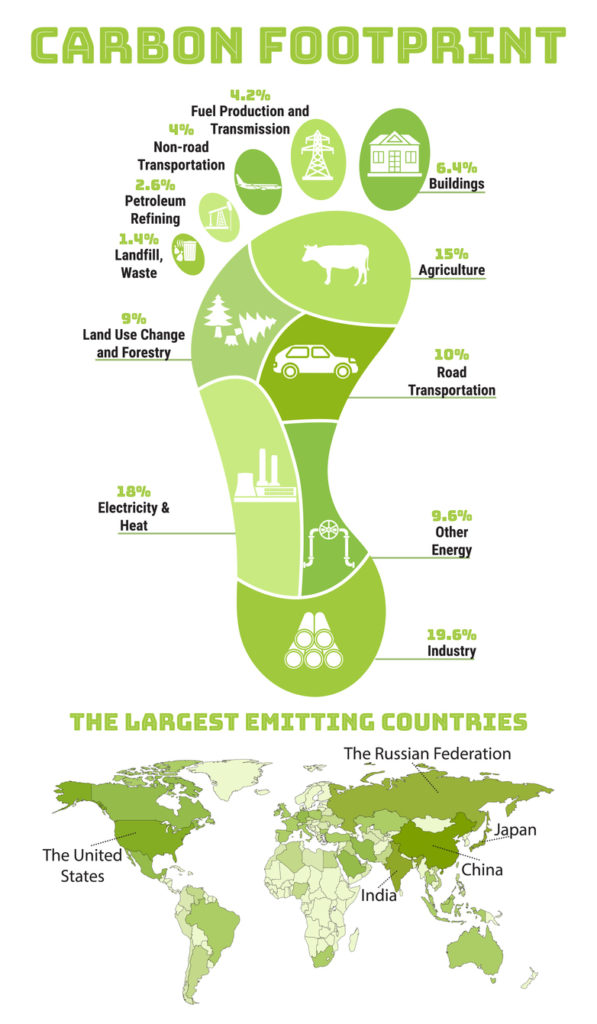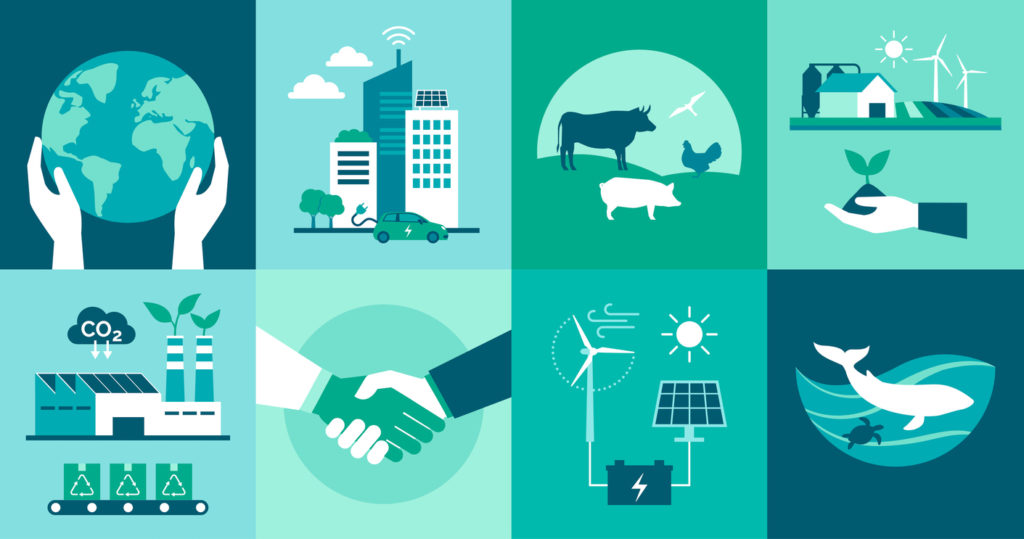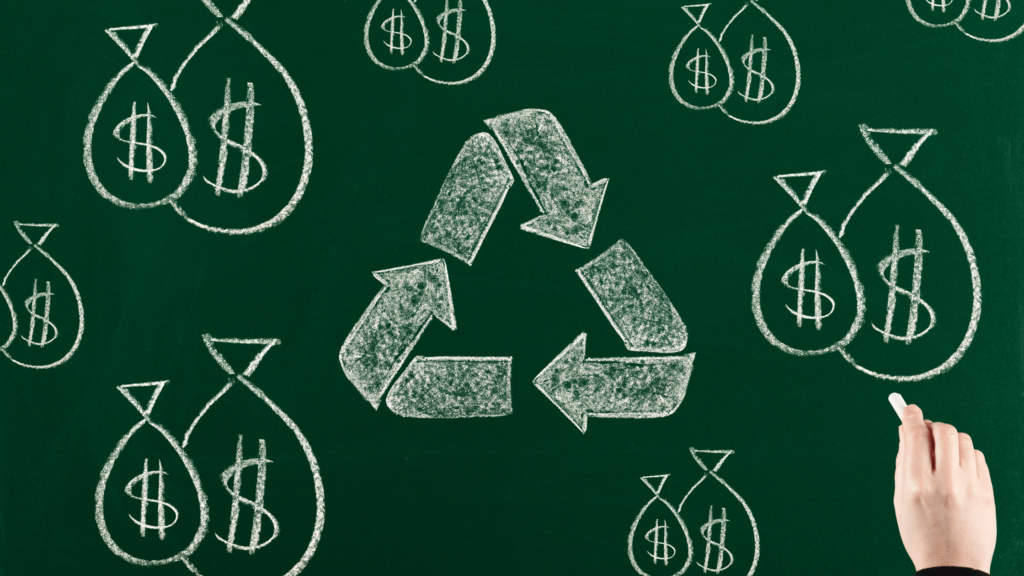Climate Savings and Your Climate Footprint (How Recycling Can Save You Money)

Most of us recycle because we want to help the environment, make an impact on global warming, and reduce our waste, but you might not have known recycling can also save you money.
Typically, when you think of how to measure the environmental impact of a product you’ve bought or an item you’ve recycled, the term ‘carbon footprint’ comes up, but there’s one term that you may have not heard as frequently as its carbon counterpart: climate footprint. We’ll explain to you how improving your climate footprint by recycling can translate into climate savings in a tangible dollar amount.
Before we dive into the concept of a climate footprint, let’s look at what a carbon footprint is and why it may not be the best way to measure a product’s environmental effects.
What is a Carbon Footprint?

We’ve all heard the term before and maybe even tried to use a carbon footprint calculator at one point or another. Let’s look at what it really is measuring.
A product’s carbon footprint measures how many total carbon dioxide emissions are released during a product’s entire lifecycle, from production to disposal. When products have a large carbon footprint, this means that the product is not very environmentally friendly because it releases a large amount of carbon dioxide emissions. So, the smaller the carbon footprint value, the more environmentally friendly a product.
The problem is that carbon dioxide is not the only harmful greenhouse gas emission that can be released during a product’s life cycle. In fact, a product’s carbon footprint value gives a very minimal look into the overall environmental impact of a product. Instead, we can look at another value for a more accurate look at these effects—climate footprint score.
What is a Climate Footprint?

Rather than only measuring one type of greenhouse gas emission, climate footprint measures all of them, including a product’s methane and nitrous oxide emissions.
Climate footprint is measured using the unit: tons/CO2e. This ‘e’ at the end means it measures all of these different greenhouse gases and converts those measurements into their carbon dioxide equivalence. For example, 1 kilogram of methane produces an equivalent of 84 kilograms of carbon dioxide. Instead of having to do this conversion ourselves, it is done for us within the climate footprint score.
Using a product’s climate footprint score instead of its carbon footprint score can show us a better overall picture of a product’s environmental impact.
Climate footprint scores can be positive or negative. A positive climate footprint score indicates that a product is adding greenhouse gas emissions to the environment during its life cycle. On the other hand, a negative climate footprint score means a product is saving greenhouse gas emissions from the environment during its life cycle. It’s best to aim for products that have this negative climate footprint value to ensure you are helping the environment as opposed to hurting it.
Climate Saving
Using your climate footprint value, it is possible to determine how much money an individual can save by recycling 1 metric ton of a certain item using a country’s carbon pricing value. Carbon pricing provides a dollar value to the amount of money spent on the social effects of pollution and emissions on the general public.
You end up wasting money through taxes or personal expenses on recovery from extreme weather events due to climate change, increased health issues from pollution, and increased prices of food production due to the same issues. These are just some of the social and economic costs of greenhouse gas emissions.
As of 2021, the social cost of carbon in the United States is $50/ton of CO2e emitted and in Canada the carbon pricing value is $40/ ton of CO2e emitted. Since there is a dollar value to your climate footprint value, this means you can save money when completing certain actions.
Recycling Saves You Money

One very important action you can take as an individual is to recycle. When you recycle any item, packaging, or material that can be recycled, you are helping your climate footprint score. Let’s look at some examples:
- That one cardboard box has extended its life cycle instead of creating more greenhouse gas emissions for new cardboard to be produced.
- Composting food waste at home for nutrient rich soil instead of letting it go to landfills reduces methane gas.
- Plastics sent for chemical recycling can be used for energy recovery instead of polluting our oceans or releasing toxins in landfills.
When you recycle to help your climate footprint, that is attached to a climate saving dollar value. That means you are saving money when you lower greenhouse gas emissions because as you help the environment, you are reducing the risks of climate change and pollution that end up costing you money through your taxes or even your personal expenses.
Make an Impact

When you look to help in reducing your carbon footprint, make sure you are looking at the whole picture and consider your entire climate footprint instead. You will be saving the amount of greenhouse gas emissions you are emitting, while also saving money. Recycling can make a bigger impact than you realize.
It is always important to know how to recycle correctly in your area. When you are unsure of what is and isn’t recyclable, you can look on the Recycle Coach Mobile App and search the ‘What Goes Where’ search tool. Otherwise, check with your local municipality about how to recycle correctly to increase your overall recovery of materials and make a bigger impact on your climate footprint.
Author Bio:
Janine Louis is an Honours Psychology and Legal Studies undergraduate student at the University of Waterloo who has worked on climate footprint research. On campus, she is the Vice-President of Community Engagement for the Legal Studies faculty and a member of the Psychology Student Society. When she’s not researching or writing, you can find her baking sweet treats or reading any book she can get her hands on!
1 Comment
Comments are closed.
Paul Louis
May 20, 2022 at 8:51 pmThis is a very informative article on a very important aspect of our lovely blue planet – its climate and the effect of green house gases being released to the atmosphere ! The more we recycle the better it is for all mankind as we are responsible for every action that produces an impact on climate change which in turn causes a repercussion and catastrophic results around us! So be aware of the climatic footprint and join the recycling movement they the recycling app! Download it now and take action before it’s too late!